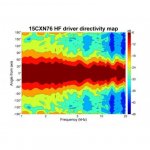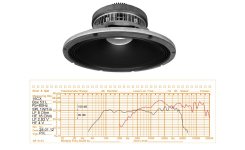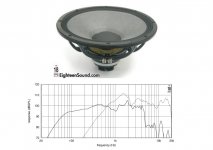Hi,
I´m giving below some different alignments for OBERTON 15CX (including the one in specs for tests), the first with accent on the response to ~30Hz (-6dB) and the second with a smaller cabinet, +/- the same rambling sound (LF) but smoother roll off.
1. VB = 150.0 L, FB = 33.0 Hz, ports 1x15.0 cmx21 cm (nxDxL), F3dB@39Hz/F6dB@31Hz/F12dB@25Hz.
2. VB = 105 L, FB = 33 Hz, ports 1x15.0 cmx35 cm (nxDxL), F3dB@48Hz/F6dB@36Hz/F12dB@26Hz.
What do you plan to do with BSC(?), because of that I would probably go with a different alignment with higher tunning, others can tell about BSC (I don't have that much experience). Also what amps you will be testing (W/power)? Check here:
3. VB = 110 L, FB = 39 Hz, ports 2x12 cmx29.3 cm (nxDxL), F3dB@42.5Hz/F6dB@36Hz/F12dB@28.5Hz.
For specs tests were made in a ""120 L box enclosure tuned 56 Hz using a 40-400 Hz band limited pink noise test signal...""
4. VB = 120.0 L, FB = 56.0 Hz, ports 3x15 cmx26.3 cm (nxDxL), F3dB@48Hz/F6dB@44Hz/F12dB@37Hz, w/ BSC@+4dB. (spec test sheet)
http://www.oberton.com/index.php?op...article&id=349:15cx&catid=99:ferrite-coaxials
I´m giving below some different alignments for OBERTON 15CX (including the one in specs for tests), the first with accent on the response to ~30Hz (-6dB) and the second with a smaller cabinet, +/- the same rambling sound (LF) but smoother roll off.
1. VB = 150.0 L, FB = 33.0 Hz, ports 1x15.0 cmx21 cm (nxDxL), F3dB@39Hz/F6dB@31Hz/F12dB@25Hz.
2. VB = 105 L, FB = 33 Hz, ports 1x15.0 cmx35 cm (nxDxL), F3dB@48Hz/F6dB@36Hz/F12dB@26Hz.
What do you plan to do with BSC(?), because of that I would probably go with a different alignment with higher tunning, others can tell about BSC (I don't have that much experience). Also what amps you will be testing (W/power)? Check here:
3. VB = 110 L, FB = 39 Hz, ports 2x12 cmx29.3 cm (nxDxL), F3dB@42.5Hz/F6dB@36Hz/F12dB@28.5Hz.
For specs tests were made in a ""120 L box enclosure tuned 56 Hz using a 40-400 Hz band limited pink noise test signal...""
4. VB = 120.0 L, FB = 56.0 Hz, ports 3x15 cmx26.3 cm (nxDxL), F3dB@48Hz/F6dB@44Hz/F12dB@37Hz, w/ BSC@+4dB. (spec test sheet)
http://www.oberton.com/index.php?op...article&id=349:15cx&catid=99:ferrite-coaxials
Last edited:
Yeah, they are all pretty bad.. (might be why I never recommend them), but most aren't as bad as the Oberton. (..and the woofer, while not good with that substantial dip at 1.3 kHz, isn't really that bad, kind of a shame really.)
Maybe it's more of a question of whether you're ready to forgive the shortcomings of the concept to enjoy it's strengths.
And if you look closely, the Oberton treble doesn't look that much worse than the Beyma's. Pay attention to the scales of the graphs. And that dip over 1 kHz is something that probably can be worked around in crossover, partially at least. The treble seems to be willing to cross over around that point, so should be doable.
As to Inductor's question about BSC, I haven't thought about it yet. First have to see how it behaves in a real world situation. With some luck it could be baked in as a part of the woofer low pass. Remains to be seen.
Excluding VAT this is a MUCH better driver/deal:
B&C Speakers 15CXN76 8/ohm | Reproduktory - Koaxiální reproduktory - Koaxiální 15" | PRODANCE
B&C Speakers 15CXN76 8/ohm | Reproduktory - Koaxiální reproduktory - Koaxiální 15" | PRODANCE
Attachments
Excluding VAT this is a MUCH better driver/deal:
B&C Speakers 15CXN76 8/ohm | Reproduktory - Koaxiální reproduktory - Koaxiální 15" | PRODANCE
Mmmhhh... Don't know. Very low Qts, and the HF doesn't actually look much cleaner than that of the Oberton unit's.
If only I had the dough to try several units, but sadly that's not possible. At least from other peoples experience I can rule out a couple of them, but seems that either no-one in the whole depths of the internets has found out the holy grail of 15-inch coaxes, or they're just keeping the info to themselves.
B&C 15CX40 could work, based on my sims, but someone somewhere claimed it shouty. Is it? Dunno. Plus so much can be fixed with the right crossover, though I prefer drivers that can make do with the bare minimum of components.
Mmmhhh... Don't know. Very low Qts, and the HF doesn't actually look much cleaner than that of the Oberton unit's.
Are you sure you are looking correctly at the scale for each driver?
http://www.lautsprechershop.de/pdf/oberton/oberton_15cx.pdf
The Oberton is all over the place on a 10+ db scale.
The B & C however is showing a pretty linear "downward" tilt due to the angle of the woofer cone. Correct for that and then "shelve" the response between 3.5 and 7.5 kHz + high-pass and impedance correction.
The woofer is also quite a bit more linear near a typical crossover freq. between 1 & 2 kHz.
B&C shows a typical result without the shelving filter I mentioned, here (first graph showing on-axis response 2nd page):
https://www.parts-express.com/pedocs/specs/294-578-parts-express-15cxn76-specifications-46964.pdf
Last edited:
The ferrite version of that, called B&C 15FCX76 does look interesting, though... Price seems to be under 400€. Blagh, this is like going out for a pizza and not being able to decide on the toppings. With the added perk that if you decide wrong, the pizza also has laxatives.
The ferrite version of that, called B&C 15FCX76 does look interesting..
Yup, and it's about 50 Euros cheaper.
http://www.prodance.cz/15fcx76-8ohm.html
(you'll get better detail retrieval from the slightly lighter mms neo magnet version though.)
Are you sure you are looking correctly at the scale for each driver?
http://www.lautsprechershop.de/pdf/oberton/oberton_15cx.pdf
The Oberton is all over the place on a 10+ db scale.
The B & C however is showing a pretty linear "downward" tilt due to the angle of the woofer cone. Correct for that and then "shelve" the response between 3.5 and 7.5 kHz + high-pass and impedance correction.
The woofer is also quite a bit more linear near a typical crossover freq. between 1 & 2 kHz.
B&C shows a typical result without the shelving filter I mentioned, here (first graph showing on-axis response 2nd page):
https://www.parts-express.com/pedocs/specs/294-578-parts-express-15cxn76-specifications-46964.pdf
At first I thought the B&C graph was 10dB, but zoomed in and realised it wasn't. You're right in that the general form of the reponse on the B&C is easier than that of the Oberton. But the latter isn't that much over the place, methinks. Harder to straighten, though, I give you that.
That Beyma seems to be well liked also. But I'll investigate these new B&C drivers too.
Oh, one other thing:
B & C graphs are generally accurate.
That's nice to know. Many are not. And some BMS graphs are worse than their real world performance... Which is weird.
BMS graphs tend to show the worst case scenario: Unsuitable cabs and measured at or near Xmax if they are to be believed.
The little 5" co-axial is measured at 1W but the 5" it is based on is measured at 100W.
Haven't checked the big co-axials but there are some woofers measured at 1kW!
The little 5" co-axial is measured at 1W but the 5" it is based on is measured at 100W.
Haven't checked the big co-axials but there are some woofers measured at 1kW!
The 15FCX76 sims actually look quite good. A person slightly wiser than me told me that if I wanted to make a passive solution out of these PA drivers, I should look for the more claustrophobic ones. Well, the FCX looks like that, 150 litres is still a little small, but the predicted low end response is best of all of the candidates so far.
Thanks to ScottG to pointing me to drivers I wasn't even aware of, this might be just what the doctor ordered. Not yet decided on these, but it's starting to look promising. And even the price seems bearable, especially for a B&C unit... They tend not to be the cheapest.
Thanks to ScottG to pointing me to drivers I wasn't even aware of, this might be just what the doctor ordered. Not yet decided on these, but it's starting to look promising. And even the price seems bearable, especially for a B&C unit... They tend not to be the cheapest.
Obertonoberton 15CX vs. 18Sound 15NCX750
OP, check how the picture from the 18SCOAX doesn't have a horn?! (note)
15CX
0040 15NCX750 - Coaxials 15NCX750 : Eighteen Sound - professional loudspeakers
18Sound 15NCX750
18Sound 15NCX750H w/ horn
In that respect those range outputs are very similar indeed. They look like a facsimile almost.The Oberton is all over the place on a 10+ db scale.
The B & C however is showing a pretty linear "downward" tilt due to the angle of the woofer cone. Correct for that and then "shelve" the response between 3.5 and 7.5 kHz + high-pass and impedance correction.
The woofer is also quite a bit more linear near a typical crossover freq. between 1 & 2 kHz.
OP, check how the picture from the 18SCOAX doesn't have a horn?! (note)
15CX
0040 15NCX750 - Coaxials 15NCX750 : Eighteen Sound - professional loudspeakers
18Sound 15NCX750
18Sound 15NCX750H w/ horn
Attachments
OBERTON 15CX vs. B&C 15FCX76
You will double the speaker enclosure Vb from the Oberton (and B&C 15CXN76) with/for the B&C 15FCX76 enclosure and it will have more 4dB@30Hz with later roll off meaning a stronger bass line (LF extension).
OBERTON 15CX - 88dB@30Hz
B&C 15CXN76 - 86dB@30Hz B&C Speakers
B&C 15FCX76 - 92dB@30Hz B&C Speakers
You will double the speaker enclosure Vb from the Oberton (and B&C 15CXN76) with/for the B&C 15FCX76 enclosure and it will have more 4dB@30Hz with later roll off meaning a stronger bass line (LF extension).
OBERTON 15CX - 88dB@30Hz
B&C 15CXN76 - 86dB@30Hz B&C Speakers
B&C 15FCX76 - 92dB@30Hz B&C Speakers
The 15FCX76 sims actually look quite good. A person slightly wiser than me told me that if I wanted to make a passive solution out of these PA drivers, I should look for the more claustrophobic ones. Well, the FCX looks like that, 150 litres is still a little small, but the predicted low end response is best of all of the candidates so far.
I've been playing around in WinISD with these drivers, and the 15FCX76 looks like a clear winner. 180 litres looks like a possible starting point, I don't want to make them any bigger than necessary. After all, my living room's only ~20m2.
But then I had a stupid idea. The 12FCX76 would fit right in my enclosures made for the BMS 12C362, and would make a slight but noticeable turn to better, why not try that instead? Wouldn't have to make new cabs... But that's just the lazy side of me thinking. The price for the drivers isn't much different, so why bother with small improvements when larger are possible.
But then I had a stupid idea. The 12FCX76 would fit right in my enclosures made for the BMS 12C362, and would make a slight but noticeable turn to better, why not try that instead? Wouldn't have to make new cabs... But that's just the lazy side of me thinking. The price for the drivers isn't much different, so why bother with small improvements when larger are possible.
but seems that either no-one in the whole depths of the internets has found out the holy grail of 15-inch coaxes, or they're just keeping the info to themselves.
*cough
Tannoy
But sadly they show no FR measurements. I don't mean to say that frequency response is the only measurement of a driver, but that graph would greatly help to get a glimpse of its real world performance.
It is relatively flat but it distorts like duck.
- Home
- Loudspeakers
- Multi-Way
- The umpteenth large format coaxial driver thread


